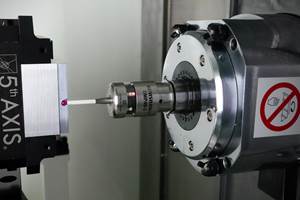Surface Texture From Ra to Rz
The irregularity of a machined surface is the result of the machining process, including the choice of tool; feed and speed of the tool; machine geometry; and environmental conditions. This irregularity consists of high and low spots machined into a surface by the tool bit or a grinding wheel.
The irregularity of a machined surface is the result of the machining process, including the choice of tool; feed and speed of the tool; machine geometry; and environmental conditions. This irregularity consists of high and low spots machined into a surface by the tool bit or a grinding wheel. These peaks and valleys can be measured and used to define the condition and sometimes the performance of the surface. There are more than 100 ways to measure a surface and analyze the results, but the most common measurement of the mark made by the tool, or the surface texture, is the roughness measurement.
It is not uncommon for different parties involved in the production to use different methods for roughness measurement. In this column we will talk about only two of the many methods of roughness measurement, how to convert between these two methods, and how to avoid the problems caused by the inevitable use of more than one roughness measurement.
In North America, the most common parameter for surface texture is Average Roughness (Ra). Ra is calculated by an algorithm that measures the average length between the peaks and valleys and the deviation from the mean line on the entire surface within the sampling length. Ra averages all peaks and valleys of the roughness profile and then neutralizes the few outlying points so that the extreme points have no significant impact on the final results. It's a simple and effective method for monitoring surface texture and ensuring consistency in measurement of multiple surfaces.
In Europe, the more common parameter for roughness is Mean Roughness depth (Rz). Rz is calculated by measuring the vertical distance from the highest peak to the lowest valley within five sampling lengths, then averaging these distances. Rz averages only the five highest peaks and the five deepest valleys—therefore extremes have a much greater influence on the final value. Over the years the method of calculating Rz has changed, but the symbol Rz has not. As a result, there are three different Rz calculations still in use, and it is very important to know which calculation is being defined before making the measurement.
In today's global economy, machined parts are being made and shipped around the world. As a result, manufacturing and quality control engineers are often forced to decide whether or not to accept a part when the print requirements are not consistent with measurement on the surface gages in the local facility. Some quality control engineers might even assume that if a part is checked and passed using the parameter available, the part would also pass other checks. In these cases, the engineers are assuming a constant correlation, or ratio, exists between different parameters.
If there were no choice but to accept some assumptions, there are rules of thumb that can help clear up the confusion and convert Ra to Rz or Rz to Ra. If the manufacturer specifies and accepts the Rz parameter, but the customer uses the Ra parameter, using a ratio range for Rz-to-Ra = 4-to-1 to 7-to-1 is a safe conversion. However, if Ra is used as an acceptance criteria by the manufacturer, but the customer accepts Rz to evaluate the part, then the conversion ratio would be much higher than 7-to-1, possibly as high as 20-to-1. Keep in mind that the actual shape of the part's profile will have a significant impact on these ratios.
Communication at the outset of the project can avoid most surprises. The approximate, and sometimes questionable, comparisons can be avoided by developing an understanding of exactly what a parameter on a print means, and how the various parties involved in the production plan to check surface texture. The best way for those involved in the production to be in agreement on the parameters for measurement is to have capable evaluation equipment in both the manufacturer's and customer's facility, making the same check using the same method. If the manufacturer or the customer uses conversion ratios, then both parties should be aware of the use of the ratio and be comfortable with the ramifications.
Related Content
What Should Machinists Know About In-Machine Probing?
In-machine probing doesn’t reach the power of CMMs but can still be useful for pre- and mid-process control, as well as for “rough screening” of parts.
Read More5 Things CNC Operators Must Know About Sizing Adjustments
For CNC operators, sizing adjustment is an essential skill. Keep these points in mind when training new CNC users.
Read More6 Machine Shop Essentials to Stay Competitive
If you want to streamline production and be competitive in the industry, you will need far more than a standard three-axis CNC mill or two-axis CNC lathe and a few measuring tools.
Read MoreHow to Calibrate Gages and Certify Calibration Programs
Tips for establishing and maintaining a regular gage calibration program.
Read MoreRead Next
The Cut Scene: The Finer Details of Large-Format Machining
Small details and features can have an outsized impact on large parts, such as Barbco’s collapsible utility drill head.
Read More3 Mistakes That Cause CNC Programs to Fail
Despite enhancements to manufacturing technology, there are still issues today that can cause programs to fail. These failures can cause lost time, scrapped parts, damaged machines and even injured operators.
Read More







.png;maxWidth=300;quality=90)














